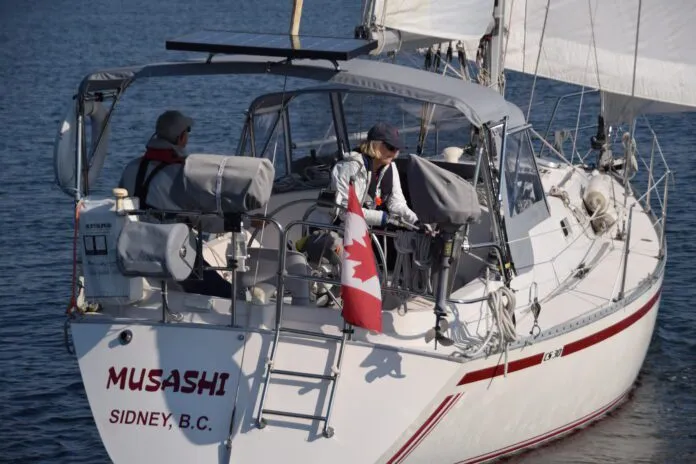

Jack and Marilyn Williams moved west from their home province of Ontario in 1977, settling on the Victoria area on Vancouver Island. One priority was to get out on the surrounding ocean water. Their first boat, an O’Day 27 purchased in 1978, was sailed extensively through the spectacular cruising grounds of British Columbia, including a voyage out to Barkley Sound on Vancouver Island’s wild west coast. With experience acquired, their horizons stretched further afield and they desired more carrying capacity and comfort. The search for a larger boat was on! A friend sailed a CS 36, a significantly larger boat, and it was a bit more than they were prepared to take on. However, they were impressed by the Canadian Sailcraft quality, and a review of a new-to-the-coast CS 30 caught their eye. Intrigued, they watched for listings in local boating magazines and found their perfect boat, a two-year-old model that met all their expectations. Jack and Marilyn were soon owners of Musashi, a 1986 CS 30 in pristine condition. They retained the Musashi name, a historical Japanese folk hero of the samurai era who was an author, artist, philosopher and swordsman. An artistic rendering of the hero remains framed on the cabin bulkhead.
With Musashi, their sailing life expanded, including a 1991 Vancouver Island circumnavigation, a 30 day, 800 nm adventure proving the CS 30 capable of open ocean seas. Winds on the west coast can easily reach 40 knots at headlands with whitecapped following seas under blue skies, a west coast sailor’s dream!
DESIGN
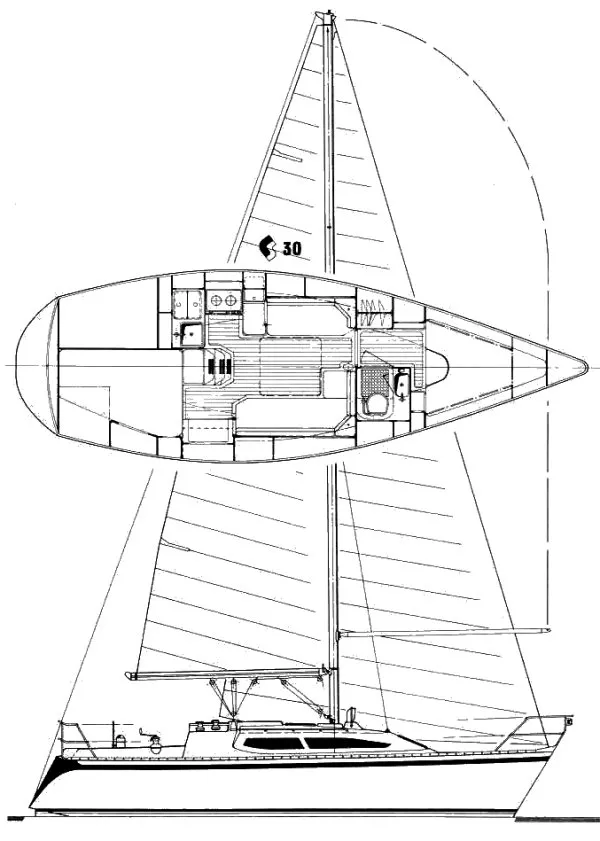
Leaning towards the IOR-influenced designs of the 1980s, the CS 30 is essentially a slippery hull aimed at being fast, while presenting a comfortable cruising interior. Created by transplanted British designer Tony Castro, the CS 30 complemented the Canadian Sailcraft line-up between the 27s and 33s, taking many design cues from those two popular Castro designs. With an extensive background in developing race boats to current rules, Castro stepped away from those restrictions to create a go-fast cruising boat that excels at all points of the wind. A slim bow, beamy midship and tapered stern all point to a hull that sails well to windward. The tall rig and deep keel complement that ability. For those more committed to the cruising life, or perhaps racing in shallow waters, Castro also optioned a winged and shoal draft keel.
CONSTRUCTION
Canadian Sailcraft had a well-earned reputation for quality construction and finish throughout their production line. The CS 30 was no exception. Constructed in Brampton, Ontario from 1984 to 1990, 500 emerged from the factory door to waiting sailors. The single-skin hull with balsa-cored deck produced a comparatively light hull strengthened by a bonded fiberglass substructure under the cabin sole. The hull/deck joint is an inward-turned flange bolted through the anodized toe rail on 4-in. centers with butyl tape used as a sealant. Interestingly, where most aluminum toe rails of this era were slotted, the CS 30 has evenly spaced holes—the number of holes doubling in the aft third of the rail.
The 3,440 lb fin-style lead keel draws 5-ft. 6-in. The optional winged keel adds another 140 lbs. with a 4-ft. 6-in. draft, and the shoal keel is 400 lbs. heavier with a 4-ft. 3-in. draft. All three keel options are attached directly to the hull with a double row of stainless-steel bolts. There is no keel stub as part of the hull and this results in a very shallow bilge sump under the floorboards—too shallow for the installation of a standard immersion-style bilge pump. A factory-installed manual pump is easily accessible to the helm position in the cockpit locker. Jack reports that the sump is generally dry, but with such a small capacity in the bilge before the floorboards start floating, I would be installing a remote bilge pump with high water alarm, just for peace of mind while pounding through waves.
A variety of interior fiberglass moldings are bonded to the hull, including the salon settees and the galley and head cabinetry. Functional and durable, there is a somewhat stark appearance to these areas. Fortunately, that is offset with an abundance of oiled teak as a hull liner, bulkhead and trim in the main cabin. The combination of teak and off-white finish provides a light interior, not one overwhelmed with dark wood, as was common in many contemporary boats of the era.
DECK AND RIGGING
The Isomat keel-stepped, double-spreader, anodized-aluminum mast has all shrouds terminating at single chain plates set well inboard of the toe rail. This leaves a clear, unobstructed passage forward. However, without lower shrouds spaced fore and aft, there is a risk of mast pumping in heavy seas. A jackstay has been provided as a preventive measure. The chain plates are bolted to the internal bulkhead, tucked behind removable fiberglass covers. There was some evidence of water leaks in this area aboard Musashi and sealant around the chainplates should be checked regularly.
The mast has an integrated spinnaker track on the forward edge, control lines for the car are included. However, without bearings of some kind on the car it would be difficult to move under load. All running rigging is internal to the mast and exits at the base, turning out to deck organizers and back to line stoppers with Lewmar 30 self-tailing winches at the trailing edge of the coach roof. This is a perfect set-up for the cruising family, or single-handed sailor, but not ideal for the racer. It’s going to get crowded in the cockpit and, with halyards exiting the mast at deck level, there is no provision for rapidly pumping sails up at the mast, particularly flying sails.
The stem fitting at the bow is cast aluminum, incorporating a single bow roller and fairleads for dock lines. The anchor locker lid has a molded arch at the forward edge for an anchor shaft reaching back from the roller. Unfortunately, this set-up does not lend itself to an easy installation of a windlass, something Jack is seriously considering as his next project.
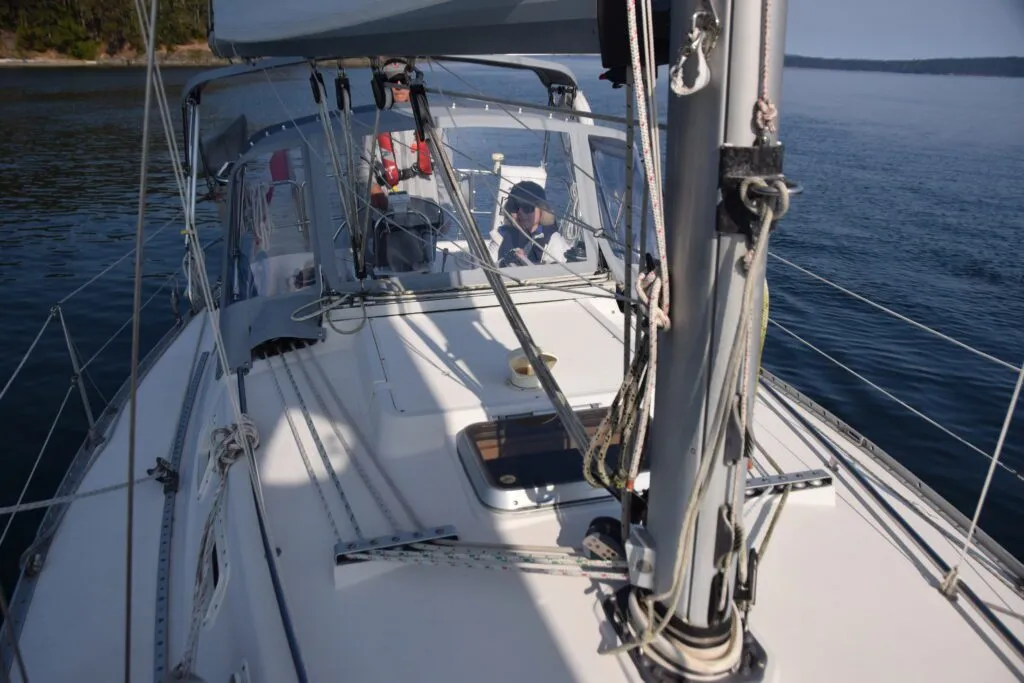
At the aft end of the boat, the backstay is secured to a chainplate mount low on the slightly reversed transom. Adding an adjustor would require some thought, the attachment point to the chainplate being almost out of reach. A remote hydraulic system would work well here.
The deck itself has a molded, non-skid texture that has survived very well over the years. Contrary to the tradition of the day, the cabin top handrails on the CS 30 are stainless steel, not high-maintenance teak as common on many of her contemporaries. Musashi has four opening ports on each side of the cabin trunk, a large deck hatch over the V-berth, another over the main cabin and a smaller hatch over the head. For inclement weather, a single dorade vent provides circulation in the main cabin. This is more than adequate ventilation for a Canadian boat where it’s more important to keep the rain out than to let a tropical breeze in! I am somewhat surprised that an opening port was not installed in the galley to help ventilate cooking moisture. There is certainly room for one and installation would not be difficult.
Sail tracks long enough for virtually any size headsail hug the cabin trunk allowing for close sheeting angles. The mainsheet traveller is mounted on the cabin top over the companionway sea hood, keeping the traveller out of the cockpit. Although the cabin top would not be considered cluttered, the multiple hatches, sail control lines and sea hood leave little room for feet when securing the mainsail onto the boom.

Unlike more modern designs with shallow cockpits (allowing for tall, roomy aft cabins), the CS 30 has a wonderfully deep and secure cockpit. Seating is long and wide with cut-outs to accommodate the 36-in. wheel mounted on a guarded pedestal. Seat backs/coamings are tall enough to provide excellent back support. Although the full-height bridge deck ensures that any seas flooding into the cockpit won’t run into the cabin, it does make climbing into the cabin a bit more cumbersome. The coamings support a pair of Lewmar 40 self-tailing genoa winches with room for additional spinnaker winches if desired. The pushpit incorporates a boarding/swim ladder and has fittings for double lifelines reaching forward to the pulpit. Properly supported entry gates are located amidships, port and starboard.
For storage and access there are two cockpit lockers. A deep locker on the port side that the average person can easily climb into for service to the back end of the engine, transmission, hot water tank and various electrical paraphernalia; and a smaller lazarette locker under the lid of the raised steering seat. Jack has affixed a more comfortable chair onto this raised hump, allowing better visibility forward when powering. Under sail, of course, the premium seats are the two coamings, windward or leeward side.
SAILS
Jack and Marilyn purchased a new full batten main and 110% genoa five years ago. These, along with an asymmetrical spinnaker in a sock and a seldom used 150% genoa, complete the sail inventory. Lazy jacks make easy work of lowering the main sail and the Harken furler ensures the genoa is always under control.
ACCOMMODATIONS
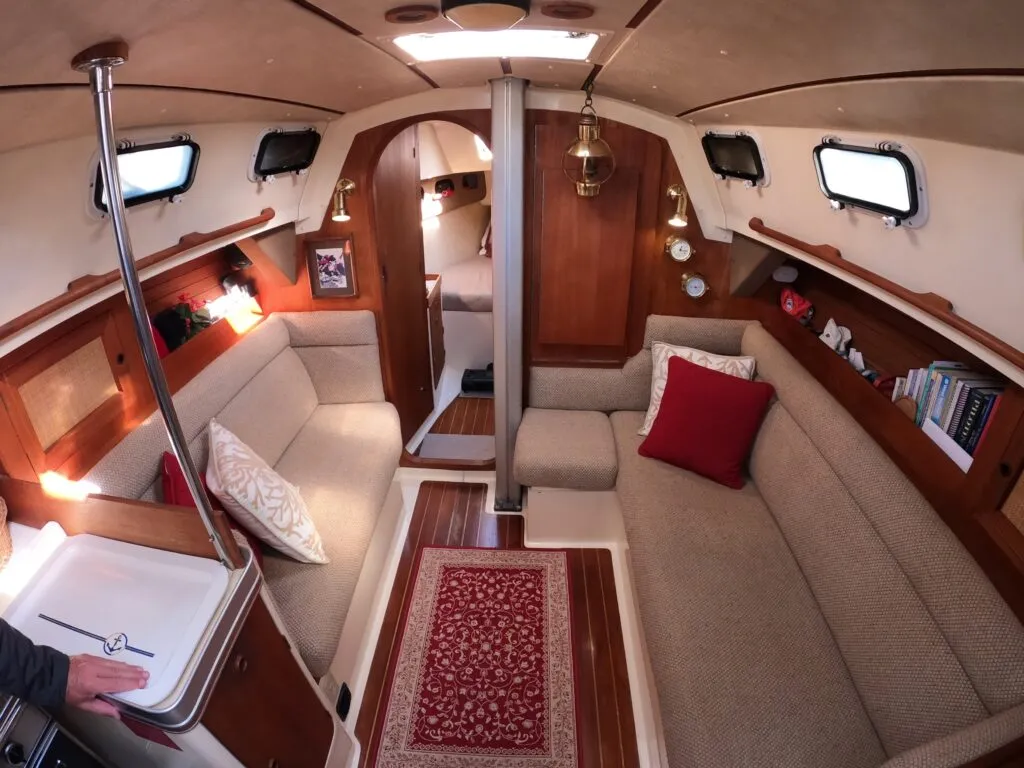
Climbing over the bridge deck and into the companionway, my first impression was the interior is a bright, efficient use of space. The multitude of hatches and portlights provide a light, airy feel to the cabin. The use of off-white interior panels lends an almost spartan appearance, making the interior appear spacious while complementing the teak trim.
The U-shaped galley is immediately to port. A deep single sink with both pressure and hand-pumped water is near the centerline next to the companionway. A good-sized icebox is next to it against the hull.
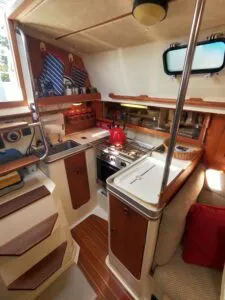
For longer sailing adventures, Jack has added a portable Dometic cooler/freezer positioned adjacent to the side of the engine compartment in front of the quarter berth. This 12-volt unit adds flexibility and capacity to food storage. A gimbled, two-burner propane range with oven is against the hull with storage behind it. There is also excellent storage in an island cabinet projecting out towards the centerline, completing the U-shape. With plenty of counter space, this galley is impressive for a 30-foot boat.
To starboard is a small navigation station with a pull-out stool. There is limited room for navigational instrumentation and the chart table will hold the typical chart book. As is common with navigation tables, the storage inside the table ends up being a catch-all along with the usual navigational equipment. Aft of the table is a double-wide, and very long, open quarter berth. Where many quarter berths of this type are restricted in width by the engine compartment, on the CS 30 the engine is forward of this berth and the mattress stretches all the way to the cockpit locker on the port side. There is certainly no sitting headroom under the cockpit sole, but lots of shoulder room.
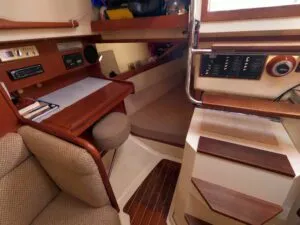
The main cabin is bright and airy with nicely finished teak accents to the off-white fiberglass structures. The starboard settee could be considered a berth on its own and can also be pulled out into a double. The 30 gal (136 L) freshwater tank is located underneath. Additional storage is available behind the seatbacks. The port-side settee is considerably shorter with storage under and behind. A fold down table on the bulkhead would easily seat four and is out of the way when not in use. When sailing in boisterous seas, hand holds include oiled teak rails that run the length of the cabin under the portlights, and a stainless-steel post at the galley island. Teak and holly floor panels add warmth to the cabin and are screwed down to the substructure, allowing for complete removal if required.
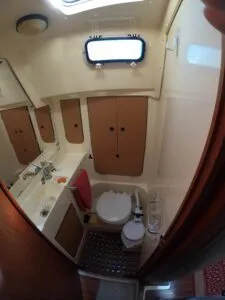
Moving forward, the head is a separate compartment to starboard, virtually all off-white gelcoat finish with an integrated sink topping a storage cabinet. Plumbing for a shower is included. Simple to keep clean. With an opening port and deck hatch, ventilation is good, particularly when the shower is in use.
Opposite the head is a substantial hanging locker. The door to this locker performs a double duty, providing a degree of privacy to the V-berth compartment when set in that position.
The V-berth is relatively small, no question about it. Although there is a fill-in panel to create a wide mattress at the shoulders, the berth is relatively short for a 6-ft. person. Open cubbies line the hull on both sides and a drawer cabinet is adjacent to the hanging locker, also available for storage.
MECHANICAL
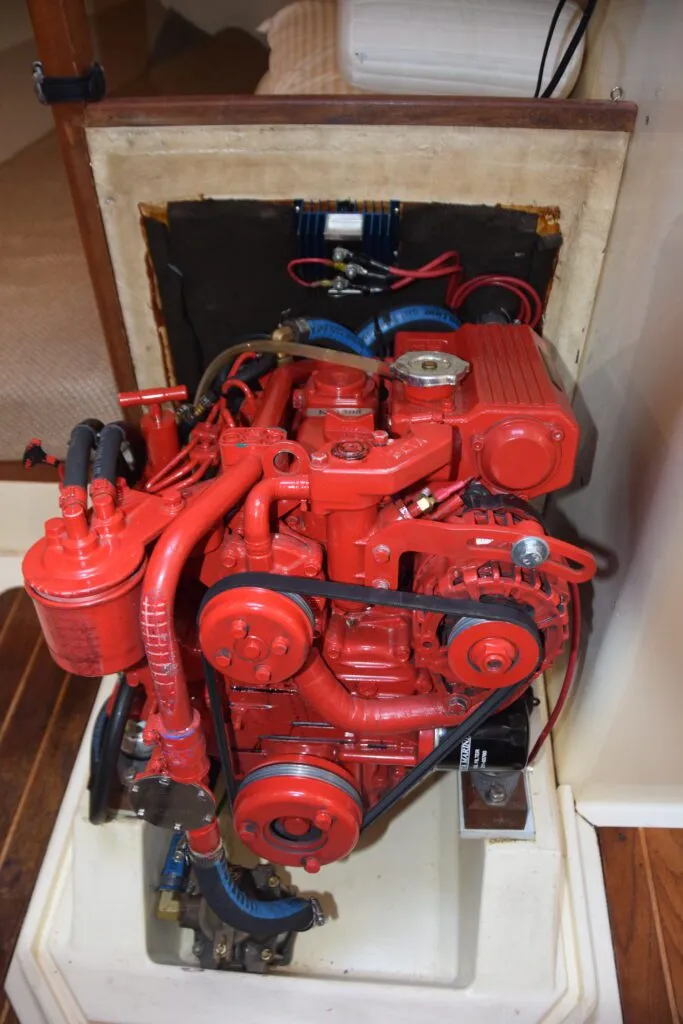
Although the CS 30 emerged from the factory with a two-cylinder Volvo Penta 2002 18-hp. diesel, Musashi is now powered with a three-cylinder Beta 20 installed in 2020. Reliability and longevity were at the forefront of that decision for Jack and Marilyn. While the power plant was out of the way, the 18-gal (82 L) aluminum fuel tank mounted behind the engine and the hot water tank in the cockpit locker were replaced. The original two-bladed fixed prop was replaced with one more suited to the Beta. The engine instrument panel is adjacent to the cockpit pedestal in a recessed panel, readily visible from the helm. The single control lever is on the port side of the pedestal guard.
Heating the interior to a comfortable level is critical in British Columbia waters, particularly in the shoulder seasons. An Espar diesel, forced-air furnace was added as a recent upgrade.
Access to the engine compartment is the bottom half of the companionway stairs, a large fiberglass box that is completely removable. The Beta 20 has all major servicing point at the front of the engine and access is excellent. Servicing the engine is not difficult. However, the ability to add sound insulation is limited by the size of the box and engine. There isn’t much room and, with the compartment open to the cockpit locker anyway, additional sound insulation would be a moot point. Fortunately, the Beta 20 is a smooth-running, three-cylinder unit with minimal vibration.
The electrical panel and battery switch are located behind the two steps of the companionway, easily visible and accessible, but tucked well away and not likely to be kicked. Two six-volt, AGM house batteries are located under the port side settee with two 12-volt starter batteries under the starboard settee. A solar panel atop the bimini frame over the aft end of the cockpit provides sufficient electrical power to keep the batteries topped up.
UNDERWAY
Sailing conditions proved to be a challenge as I climbed aboard Musashi; not a breath of wind on a calm fall day. Control under power was exactly as expected, the deep rudder in the prop wash providing precise directional control, even at low speed. Backing down with the two-bladed fixed prop was dead straight. I was expecting prop walk in one direction or the other but that was not evident. Jack cruises at about 2500 RPM with 5.5 knots of boat speed. The Beta 20 is rated for 3600 continuous RPM, leaving plenty of power in reserve. Engine noise in the cockpit was acceptable and, as mentioned earlier, the Beta 20 is a smooth-running diesel.
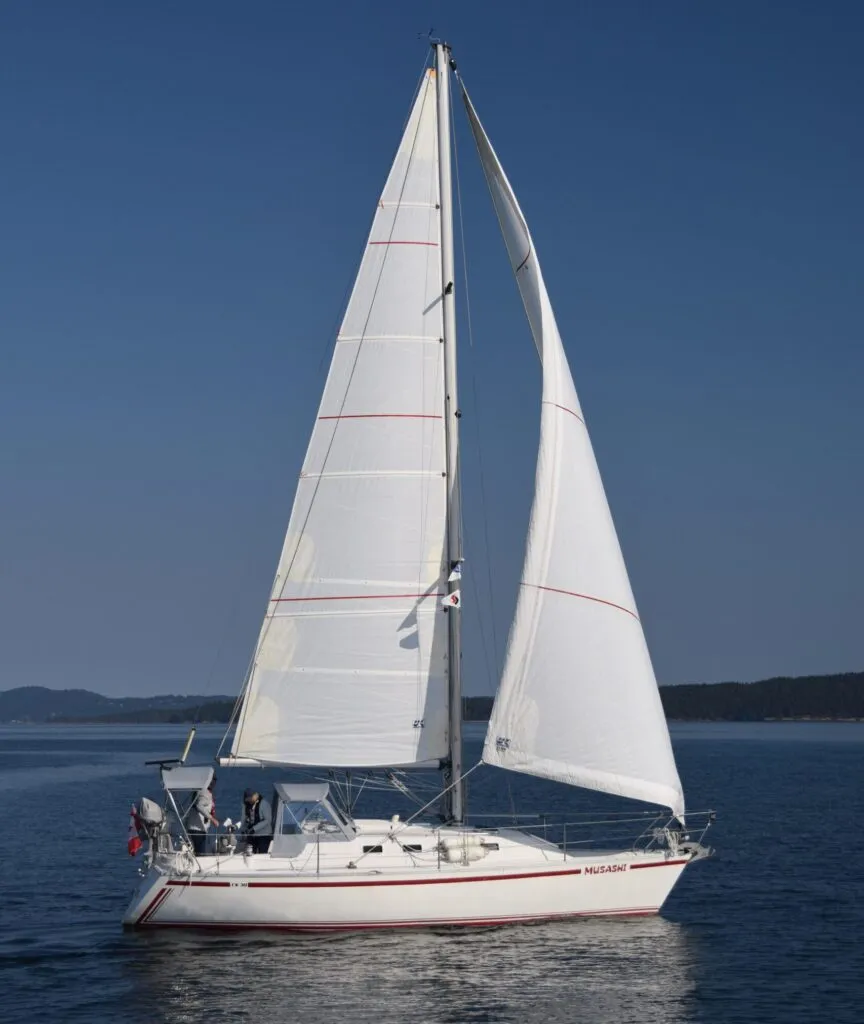
Motoring out over mirrored water we found a patch of wind. We hoisted the main on the tall rig and pulled out the genoa. The Harken roller furling performed well with smooth action. Both the full batten main and 110% genoa were about five years old with excellent shape. Musashi accelerated smoothly in the light 7- to 9-knot breeze, heeling nicely and pointing well. The cockpit coaming on the leeward side was ideal for watching sail trim and reaching the genoa sheet winch for adjustment. She tacked easily through 100 degrees and would likely do better with a bit more wind. The Whitlock-geared steering was very sensitive to the touch with no noticeable slack. No cables to adjust or maintain. The wind was too light to cause any weather helm but Jack reports that even in heavier air the CS 30 can go hands off for long distances with the sails trimmed properly.
Although we didn’t have the opportunity to sail through any seas, Jack and Marilyn reported that Musashi had no undesirable characteristics while sailing ocean waves in the Vancouver Island circumnavigation. The boat was not squirrelly in heavy following seas, and they were quite confident in her capabilities.
CONCLUSION
I believe the CS 30 is exactly what Tony Castro intended all those years ago, a fast coastal cruiser designed without the constraints of racing rules. Fast under all points of sail, efficient under power, and nimble under both, the CS 30 exemplifies quality design and production that has stood the test of time. Fastidiously maintained, Musashi is a fine example of the heyday of volume production boats. I would have no hesitation in taking this seasoned veteran for extended coastal cruising, including open ocean sails off the west coast of British Columbia.

[/su_box]
[/su_box]


































We’re sailing a 1987 Hunter 31 sloop in Salem, MA and vicinity. It shares many of the features of CS 30, especially as we have also upgraded auxiliary engine, sails, furling, traveler, GPS, Steering pedestal, and other features. Nice boat.